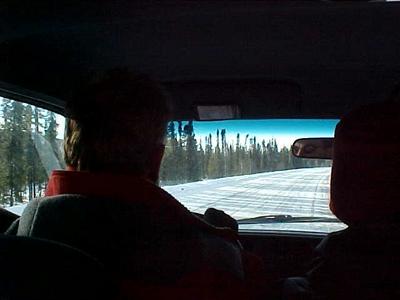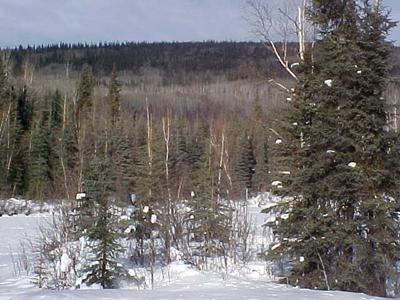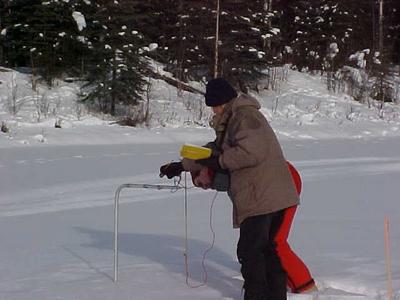22 February, 2003
THOSE "DAMMED" PONDS
It was one last trip out to Poker Flat, and one last opportunity to
reflect on the importance of these isolated ponds and the valuable
stories they have to tell. They are like many thousands of other
small ponds, sloughs, and lakes throughout Northern Alaska in that
they have become a valuable resource for humans. They hold part of
the secret of climate change, but have served many other groups
besides ice and climate researchers. Fishermen, snowmobile
enthusiasts, and trappers have all relied on these small water bodies
for recreation and for survival.
Today we came across a team of beaver trappers who, using the
modern conveniences of trucks, chainsaws, and snow machines were
setting traps in two of the ponds. One of the trappers had been
visiting this same area for fifty years, and had begun trapping when
it meant hiking into the wilderness with a backpack.

On the road to Poker Flat

The ponds are surrounded by birch, aspen, and spruce.

Today's trappers cut through the thick lake ice using a chainsaw.

Trapping, like hunting, requires a true appreciation for sustaining wildlife populations and an understanding of management versus exploitation. While the beaver "dam" or house may hold between six to eight animals, a maximum of two animals per season will be taken from the pond. None of the animal will go to waste. The pelt as well as the fatty meat will be utilized.

The "bait" of green cottonwood (a favorite snack for the beavers) is set outside of the beaver house. During severe winters the beavers may starve or they may injure their mouths and teeth by trying to gnaw their way out of their houses through the frozen soil.

Martin and Mike use the hotwire device to confirm that the ice is about 80 cm thick.
Contact the TEA in the field at
.
If you cannot connect through your browser, copy the
TEA's e-mail address in the "To:" line of
your favorite e-mail package.
|
